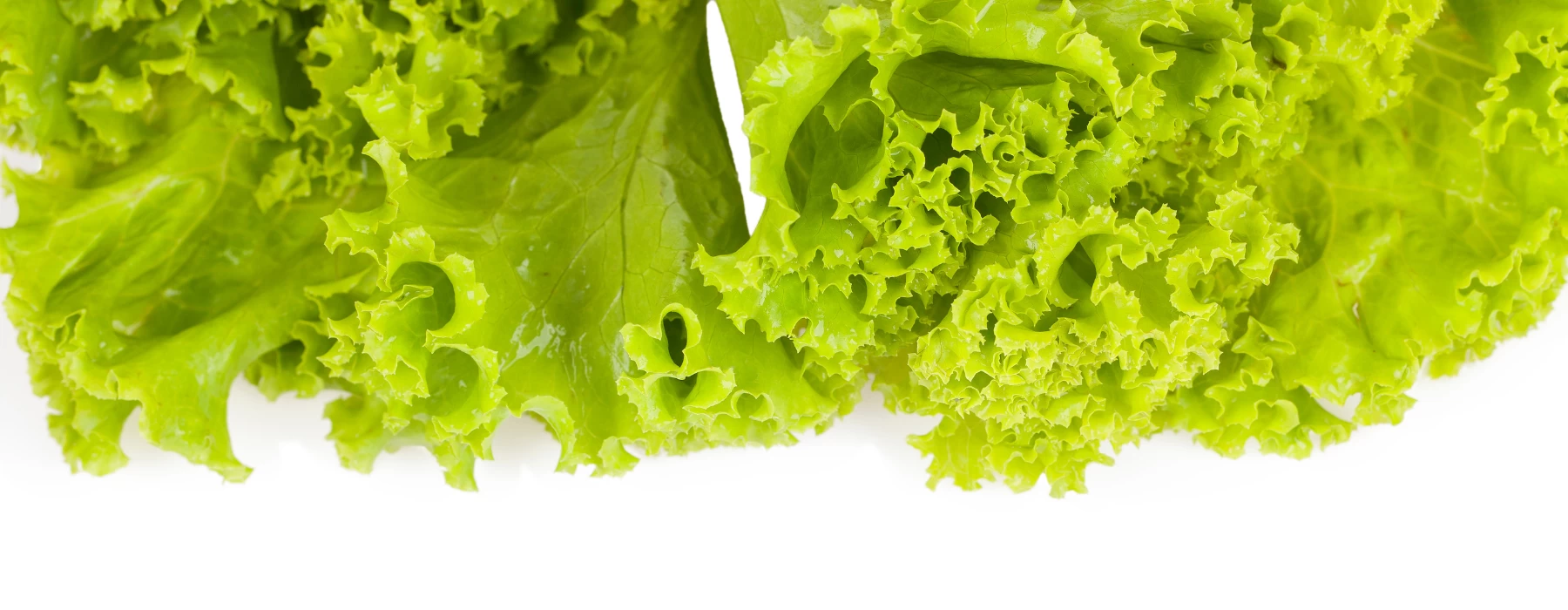Lettuce
Lettuce

Lettuce is a salad green. They are sturdy, crunchy, and packed with nutrition. It belongs to the daisy family. It varies in colour from yellow to dark green. It is grown all over the world. Largest producer of lettuce is China. Lettuce is used in salads in addition to making wraps, soups, and sandwiches. There are 5 types of lettuce out of which romaine and iceberg are the most common types. Let’s discuss all the varieties of lettuce:
1. Romaine lettuce
It is very common in Caesar salads. The premature leaves are sometimes red in colour, otherwise romaine lettuce are green in colour and have a crunchy texture. It is also called cos. Nutritional facts of romaine lettuce per 100 gms:
|
Calories |
17 |
|
Protein |
1 gram |
|
Fiber |
2 grams |
|
Folate |
34% of RDI |
|
Iron |
5% of RDI |
|
Manganese |
7% of RDI |
|
Potassium |
5% of RDI |
|
Vitamin A |
48% of RDI |
|
Vitamin C |
4% of RDI |
|
Vitamin K |
85% of RDI |
Romaine lettuce is a very good source of Vitamin A, vitamin K and folate. These nutrients are potential antioxidants and are essential for healthy eye, skin, and immune system. Romaine lettuce is high in plant compounds, especially caffeic acid and chlorogenic acid. These compounds are linked with reduced risk of heart disease, inflammation, and cancer. Young leaves that are red in colour are high in anthocyanins. These pigments are linked with reduced risk of heart disease and cognitive decline. Romaine lettuce is commonly used in salads, especially Caesar salads. It is also used in making soup and stir fries. It is slightly sweeter and bolder in flavor when compared with iceberg lettuce.
2. Iceberg lettuce
It is the most commonly used lettuce all over the world. Iceberg lettuce is also called crisphead or head lettuce. It’s appearance is like cabbage., but it is completely different from cabbage. Nutritional facts of iceberg lettuce per 100 gms:
|
Calories |
14 |
|
Protein |
1 gram |
|
Fiber |
1 gram |
|
Folate |
7% of RDI |
|
Iron |
2% of RDI |
|
Manganese |
5.4% of RDI |
|
Potassium |
3% of RDI |
|
Vitamin A |
3% of RDI |
|
Vitamin C |
3% of RDI |
|
Vitamin K |
20% of RDI |
Iceberg lettuce is especially good in folate and vitamin K. Folate is essential, especially in pregnant women to help prevent neural tube defects. It is also linked with reduced risk of heart disease, pancreatic cancer, and breast cancer. Vitamin K is vital for blood clotting, bone formation, and heart health. Iceberg is also good in plant compounds, potent antioxidants, which reduce oxidative stress and decrease the risk of several chronic health issues. Iceberg lettuce is mild in flavor and crunchy in texture and is frequently used in salads and sandwiches. You can store it in the refrigerator in a sealable bag with a damp paper towel.
3. Butterhead lettuce
The leaves of butterhead lettuce are soft and buttery, according to the name. Due to its round shape, it is also called cabbage lettuce. There are two common types of butterhead lettuce, Bibb and Boston lettuce. Commonly It is dark green in colour, but red varieties are also known. Nutritional facts of butterhead lettuce per 100 gms:
|
Calories |
13 |
|
Protein |
1.5 grams |
|
Fiber |
1 gram |
|
Folate |
18% of RDI |
|
Iron |
8% of RDI |
|
Manganese |
8% of RDI |
|
Potassium |
5% of RDI |
|
Vitamin A |
18% of RDI |
|
Vitamin C |
4% of RDI |
|
Vitamin K |
85% of RDI |
Butterhead lettuce is high in antioxidants, especially carotenoids, including carotene, lutein, and zeaxanthin. These compounds are linked with reduced risk of age related macular degeneration, leading to partial vision loss. Additionally, butterhead lettuce is also a good source of iron, when compared with other lettuces. Iron is vital for red blood cells formation. Iron from plant sources is non-heme iron, and is not easily absorbed. Vitamin C is needed for its absorption. Butterhead lettuce is high in vitamin C. Butterhead lettuce has a mild sweet flavor. It is used in salads, including egg -salad and tuna sandwiches. It serves as a replacement for tortillas in wraps. It can be stored in the refrigerator in a sealable bag for 2-3 days.
4. Stem lettuce:
It is very commonly used in Chinese cuisine. Other names of stem lettuce are Chinese lettuce, stalk lettuce, or celtuce. Stem lettuce is different from other lettuce as its stem is eaten and leaves are discarded. Leaves are high in latex, so very bitter in taste. Nutritional facts of stem lettuce per 100 gms:
|
Calories |
18 |
|
Protein |
1 gram |
|
Fiber |
2 grams |
|
Folate |
12% of RDI |
|
Iron |
3% of RDI |
|
Manganese |
30% of RDI |
|
Potassium |
7% of RDI |
